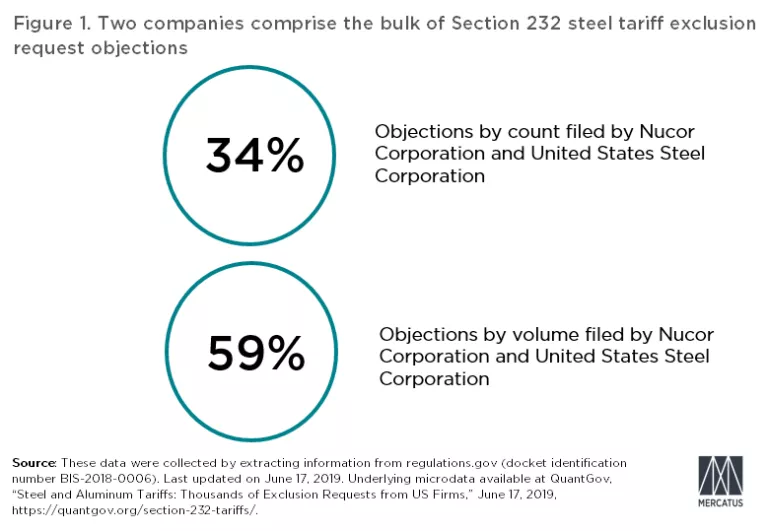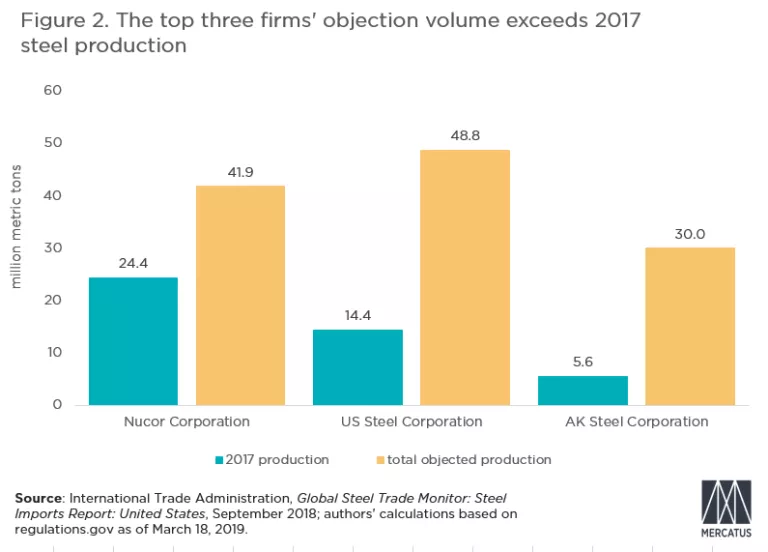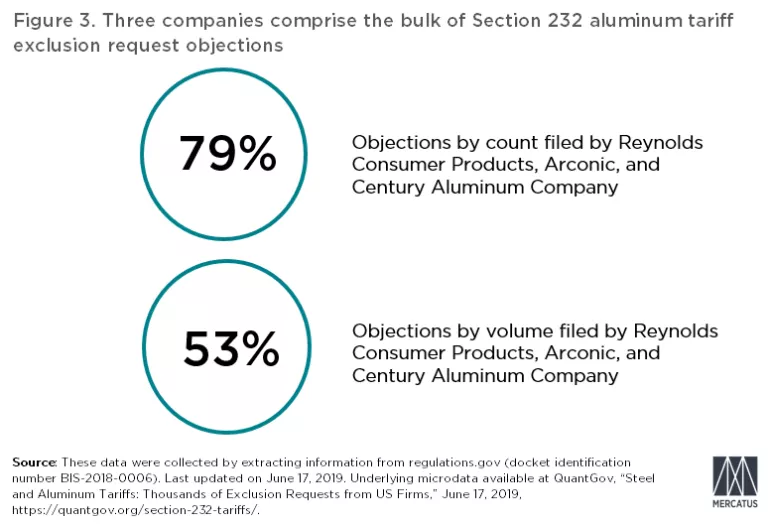- | Expert Commentary Expert Commentary
- |
Investigating Product Exclusion Requests for Section 232 Tariffs: An Update
On March 8, 2018, under Section 232 of the Trade Expansion Act of 1962, President Trump imposed a 25 percent tariff on imported steel and a 10 percent tariff on imported aluminum.
US manufacturers may request an exemption to Section 232 tariffs from the Commerce Department. If tariffed materials do not pose a threat to national security and there is insufficient domestic supply, then Commerce may issue an exemption. Other manufacturers have 30 days to object to these requests before Commerce makes its decision. The original requester may then rebut the objection within the next seven days, and the objector may file a surrebuttal in the seven following days.
In this essay, we compile updated data on the tariff exclusion requests made by US manufacturers and the outcomes of those requests as of July 30, 2019.
Steel and aluminum are key inputs for US manufacturers, who are continuing to seek tariff relief. It has been over a year since the Section 232 steel and aluminum tariffs took effect, and many manufacturers are starting to file for renewals. Since our most recent update, there have been a few key developments.
Steel
As of July 30, 2019, there have been 62,797 steel tariff exclusion requests filed by 836 US manufacturers across 288 congressional districts. This is an increase of 17,469 since mid-March. Requests for steel tariff relief are relatively dispersed across the country. The top six districts represent 34 percent of requests (TX-07, IL-06, CA-14, TX-02, MI-11, and IL-03).
Of all steel tariff exclusion requests, 30,545 (49 percent) have been approved, 13,261 (21 percent) have been denied, and 18,991 (30 percent) remain pending.
US steel producers have filed 22,210 objections, an increase of 2,667. To date, US steel producers have objected to 153.5 million metric tons or mmt, which far exceeds their 86.6 mmt of US annual production in 2018. Table 1 in the attached dataset lists the name of each objecting company, along with the number of filed objections and the total weight of requested steel exclusions to which they object in kilograms.

Out of the 75 US steel producers that have filed objections, two of them account for a large and disproportionate share. As Figure 1 displays, US Steel Corporation and Nucor Corporation represent 59 percent of the steel quantity in objections and 34 percent of all objections filed.

In the first 12 months alone, the objection volume by each steel producer exceeded its annual production. Figure 2 displays these data.
Aluminum
As of July 30, there have been 9,974 aluminum tariff exclusion requests, an increase of 3,957 since mid-March. Of these requests, 4,978 (50 percent) have been approved, 862 (nine percent) have been denied, and 4,134 (41 percent) remain pending.
Aluminum tariff exclusion requests have been filed by 224 US manufacturers across 149 congressional districts. Over half of the requests for aluminum tariff relief are from a handful of congressional districts (the top six districts, IL-05, GA-11, NC-04, NY-21, OH-01, and WI-06, make up 51 percent of the requests). Aluminum tariff exclusion requests are more concentrated than those for steel.
US aluminum producers have filed 2,456 objections (an increase of 1,521). Table 2 in the attached dataset displays the objecting companies along with the number of filed objections and the total weight of requested aluminum exclusions to which they object in kilograms.

As Figure 3 displays, the objections are concentrated among three aluminum producers, which together account for 79 percent of the objection quantity and 53 percent of the number of objections filed.
The Approval Rate is Higher for Requests With No Objections
Requests without objections appear to have a higher approval rating. For steel tariff exclusion requests with at least one objection, 13 percent have been approved. For steel requests without an objection, 59 percent have been approved. Similarly, for aluminum tariff exclusion requests with at least one objection, nine percent have been approved. For aluminum requests without an objection, 57 percent have been approved.
Conclusion
The Section 232 steel and aluminum tariffs have restricted the ability of US manufacturers to access key material inputs at globally competitive prices, which leaves them at a disadvantage both here at home and abroad.
The exclusion process itself poses challenges for US manufacturers. For instance, if a US steel maker objects to their tariff exclusion requests, their chances of an approval decline sharply.
Meanwhile, the data indicate that steel producers are filing objections to more steel than they have ever produced and it is not clear domestic steel producers are even able to meet market demand in a timely manner.
The approvals are valid for one year. Many of the US manufacturers with approvals are starting to file for a renewal, leaving them to go through the entire process again.
Photo credit: Ryan McMorrow/AFP/Getty Images